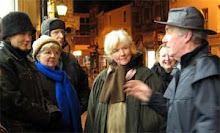
The first castle to be built at Devizes was constructed around 1080 by Osmond - Bishop of Salisbury. Osmond’s castle was a motte-and-bailey construction with a wooden three-storey tower set on a high palisade mound. The outer bailey would have included a defensive ditch, stockade and drawbridge. The castle was often used to secure prisoners of state. One such famous resident incarcerated for twenty years was Robert - Duke of Normandy, imprisoned following a lengthy dispute with his younger brother Henry I.
After its destruction in 1113 by fire, as was often the case with wooden structures, work to rebuild it was undertaken by Viceroy Bishop - Roger of Caen, who lavished a huge amount of money on its construction. Built primarily of stone this time indications are, that the new castle would of had a keep, castellated walls, a portcullis and a very deep moat, its banked sides still visible today.
The castle was badly damaged again in 1645 by repeated assaults from Cromwell’s army, who eventually won the day and seized the castle. An order was issued from parliament to have the castle ‘slighted‘, a term used to initiate dismantling. Very little remains of the original castle, though parts of the keep were discovered during the 19th century when the Leach family began work constructing a new castle in a Neo-Norman Gothic style. Towers were built to the south and north with castellated walls and an impressive gatehouse with double grid patterned timber gates set into a large Norman archway.
Over its colourful history, the castle has gained, not surprisingly, a reputation for being haunted. A mysterious woman dressed in white has been seen countless times wandering the castle's corridors. Originally, she was thought to be Lady Isabella - daughter of Charles VI of France. The story goes, that as a result of a politically arranged, turbulent and unhappy marriage to King Richard II of England, Isabella sort the attentions of another man. Isabella was often left alone in the castle and it was during one of these solitary episodes that she met and later fell in love with a young knight. The King was told of her infidelity. The knight was duly arrested and put to death but Isabella's fate was even more gruesome, for she was to be buried alive within the castle walls at the hands of her jealous husband.
The validity of this story is brought into question however, as Isabella’s forced marriage in 1396 was at the tender age of just six, so the likelihood of her engaging in a relationship with a another man would have been extremely unlikely. Not only that, but it is well documented that she returned to France aged 11 after King Richard, returning from a military campaign in Ireland, was imprisoned and later mysteriously murdered. It is also well known, that even though their marriage was arranged in an effort to calm the tensions between England and France, they were anything but at odds with one another and both carried a deep respect for each other. Therefore, the true identity of 'The Lady in White' remains a tantalising mystery.
Another of the castle's ghosts is that of a cavalier, who haunts the main staircase. He is described as very tall and seems always to be in a rush as he descends the stairs in great haste with his sword clattering at his side. Story has it, that one evening as an elderly resident was making her way up to her bedroom, she was suddenly confronted by the cavalier as he dashed past her leaving her in his icy wake. Another resident similarly climbing the stairs, was abruptly subjected to an icy blast as the apparition materialized immediately in front of him then proceeded to pass straight through him.
The sound of man’s voice has been heard coming from one of the bedrooms. During WWII the castle was used as a barracks. The story goes, that one soldier was inclined to sleepwalk to such and extent that he was forever waking the others. A decision was made to confine him to one bedroom where he was locked in at night. People who have stayed in that room have been woken by the sound of someone murmuring and a shuffling sound as if someone is moving about the room. I’m inclined to think that whatever is haunting that room must surely not be that same soldier, I can’t believe that his comrades would have locked him in and left him for dead.
Probably the most eerie of the castle's ghosts and indeed, the most active, is that of an elderly woman who has been seen in the Gallery. She is described as dressed in 19th century ‘widows weeds’, a garment worn during a time of mourning. She walks with a stoop and grasping a walking stick, but there is something a little disturbing about her presence and for that matter the Gallery in general. Over the years a succession of dogs have apparently refused to enter the room, instead preferring to stand transfixed, or howl, or growl, or all three, at something that only they can sense within the empty room.
Today the castle is privately owned and not accessible to the public. Don’t let this put you off though. Great views of the castle, its grounds and the site of the moat can be had from the Castle car park at the rear of Market Square.






No comments:
Post a Comment